Tilley was Tim Curley’s favorite dog.
Everything he’s learned in 27 years of running sled dogs, he credits to Tilley. He even spelled her name with an “-ey” to match his own last name.
“Every time I think about her, I get teary-eyed,” Curley said. “I miss her so much.”
Curley is part of the Oregon and Washington Cascade Sled Dog Club, one of the largest mushing organizations in the lower 48.
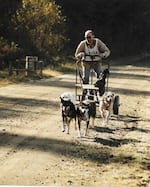
Tim Curley and his lead dog Tilley, front row, right.
Courtesy of Tim Curley
Mushing, generally, is something few people do, but more people mush than you might think, especially in the Northwest.
The sport provides mushers here an opportunity to connect on a deeper level with their pets.
Tilley was a lead dog Curley got from another musher about two decades ago. The first time they ran together, he knew their relationship would be special.
Leads play a critical role on any sled dog team. The team won’t turn unless the lead dogs turn. When a musher shouts “on by” to pass another team, it falls on the lead dogs’ shoulders to navigate past trouble.
Some lead dogs, Curley said, need a little help picking their spots.
“But her, I could just drop the reins, I could just say ‘on by,’ say it once and I knew that she would get the whole team, me, the sled around whatever the situation was,” Curley said of Tilley.
Curley and his partner, Sharon Nuckols, have 17 Alaskan huskies in their kennel now. They pick up on their dogs’ varying personalities over time.
Some are goofy and playful. Others are more noble and serious.
Tilley was a leader.
“And I had total trust in her,” Curley said.
Their connection exemplifies the unique bond mushers have developed with their dogs throughout history — a part of history we’re only beginning to understand.
Next In Line
Sunday morning in Mosier, Oregon: The sun was down. Temperatures flirted with freezing.
The first sound of gravel crunching underfoot outside the barn was enough to whip 11 Alaskan husky puppies into a barking frenzy. The 19 adults were mostly unfazed.
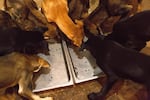
Thad McCracken's puppies scoop up the last bits of food from their morning meal.
Bradley W. Parks / OPB
Musher Thad McCracken was starting another 30-hour week with his 30 companions.
He wore work pants, calf-high mud boots and an old jacket. His salt-and-pepper beard, winter hat and glasses concealed most of his face — focused like he was trying to solve a Rubik’s cube (but confident like he knew how) as he checked tasks off his list.
It was time for the puppies’ morning meal, pre-run hydration for the adults and cage cleaning — all before loading up for the racing team’s morning run.
Many of the adults in McCracken's kennel are racing now; some are retired.1 The 11 pups are his next — and likely last — racing team.
Another musher, Robert Lee, approached the kennel from outside. The 5-month-old huskies pressed against the doorway trying to get a whiff of their visitor before he even broke the threshold. Lee opened the barn door like an overstuffed closet, one slow inch at a time, to a cascade of toddler dogs.
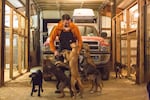
McCracken's puppies greet Robert Lee.
Bradley W. Parks / OPB
As puppies darted through the kennel with joy, McCracken kept working.
The young dogs soon huddled around two long, stainless steel pans of kibble. They ate without looking up. McCracken lured them back to their pen with another tray of food. After counting the puppies, he closed the gate and let the adults out in the kennel.
Three of Lee’s dogs would join McCracken’s team, the Mosier Misfits, to run a 12-mile course with Curley and Nuckols’ dogs that Sunday.
McCracken gave each racing dog a bowl of pre-run "beef water" for hydration and loaded them into the truck.2
Can’t Quit Your Day Job
Most dog owners know their pets require a lot of care. Working dogs — like those who run sleds — often require more. A competitive kennel like McCracken's is the product of a rigorous and efficient routine of eating, training, racing and resting.3
In his book “The Sports Gene,” David Epstein described the differences in how humans and sled dogs respond to exercise:
“As in humans, when sled dogs start training, they deplete the energy reserves in their muscles, undergo an increase in stress hormones, and damage cells. Human athletes experience this as fatigue and soreness, and must rest to allow the body to adapt to the exercise before coming back to training or racing. But the best sled dogs adapt on the run.”
Sled dogs recover from exercise in ways humans can only dream of. They are some of the most remarkable athletes on the planet.4
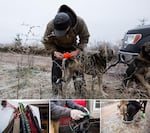
From top, clockwise: Tim Curley puts booties on one of his dogs; two of McCracken's dogs drink water; McCracken puts a harness on one of his dogs; harnesses hang from McCracken's dog box.
Bradley W. Parks / OPB
In 2016, archaeologist and University of Alberta professor Dr. Robert Losey described sled dogs as "like a cross between a human weight-lifter and a long-distance runner."
Mushers, while certainly athletes in their own right, are as much, if not more, coach than player.
Like runners, sled dogs — typically Alaskan or Siberian huskies — accumulate mileage on runs throughout the week at a calculated pace.5
Add in daily tasks like feeding the dogs, transporting them to and from runs and races, veterinary trips and more. And then, of course, there’s poop. Lots of poop.
Those responsibilities fall on humans and they add up quick.
“It’s a lifestyle,” McCracken said. “You can’t do mushing and have it be a totally separate part of your life and do it every now and again.”
Countless hours spent together pay off in those peaceful moments when the dogs’ ardent howls are replaced by the sounds of gentle panting and sleds whooshing through the snow.
“You don’t have that unless you do everything else,” McCracken said.
‘The Loudest Quiet Sport Ever’
Hoarfrost covered the Mosier highlands in crisp white.
Teams of Alaskan huskies lay quietly in warm, straw-lined compartments on the backs of pickups. Hills rolled by the dogs’ windows as the trucks climbed the aptly named Huskey Road to the trail.
The trucks pulled to a stop. That’s when the barking began.
Nuckols popped in a pair of bright orange earplugs while she and Curley unloaded their team.
“People are always amazed when you bring the harness out and just the dogs seeing the harness, they get nuts; they get all worked up,” Curley said.
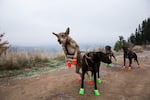
Flo, one of McCracken's lead dogs, tugs at the line before a run.
Bradley W. Parks / OPB
Dogs eager to run are very vocal in their excitement. They bark or let out that high-pitched husky howl. Some of them practically scream. You can watch the energy rattle up through their legs, into their chest and out their mouths.6
“It’s the loudest quiet sport ever,” said Kim Tinker, a Northwest skijor champion and Cascade Sled Dog Club mentor.
After unloading the dogs, the mushers set up the sleds — or in this case ATVs.7
They attached tow-lines to the front bumpers of their ATVs in 8-foot sections. Two dogs were attached to each section by tug-lines, one on each side. The two dogs in front are the lead dogs while the rest are known as wheel or team dogs.
The mushers engaged the brakes on their ATVs and McCracken anchored his to his truck. If he didn’t, nothing would keep his team of 14 energized dogs from hauling off without him — ATV and all.
The huskies waited in position, jumping, shouting and tugging wildly in anticipation.
“But as soon as you release that sled, it’s like flippin’ off a switch,” Curley said. “They’re dead quiet.”

From left: Robert Lee receives directions from McCracken; McCracken's team barrels down the trail.
Bradley W. Parks / OPB
McCracken let his brakes go first and the barking ceased. It’s when the dogs fully display their power that their noise is reduced to almost nothing.
The instant the dogs take off, mushers say, is when the adrenaline rush begins its transformation into unparalleled serenity. It’s a moment mushers and their dogs crave.
“You’re pretty sure this is exactly what heaven is like,” Tinker said.
‘You Can’t Push A Rope’
For sled dogs, takeoff is a release: Finally, they get to work.
“There’s a larger understanding that some dogs need a job,” Nuckols said.
“Even the chihuahua loves to let you know that the neighbor’s kid’s in the backyard or the mailman’s here,” Curley said. “All dogs love a job. Sled dogs love to run.”
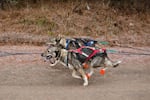
Two of Curley and Nuckols' wheel dogs race down the trail.
Bradley W. Parks / OPB
Humans have kept dogs for thousands of years. Archaeological evidence has begun to show that we’ve used dogs to pull us and our stuff for millennia as well.
Losey, the University of Alberta professor, said the best evidence for that is at a site called Ust-Polui in Siberia. There, Losey and others have found the remains of about 125 dogs, an unusually high number.
“But it also has remains of sleds — quite elaborate sleds with skis and stanchions that were raised up to a raised bed,” he said.
They’ve also found possible sledding tackle like swivels, buttons and clasps — even a knife with what appears to be a sled dog carved on the handle. Those findings have led his team to believe humans have used sled dogs for at least 2,000 years, possibly longer.
We know much less about sled dogs in North America, however.
Native communities have long used sled dogs to move around the North American Arctic. Dogs also played a role in the Klondike Gold Rush in the late 1800s. The U.S. Postal Service used teams of sled dogs to carry mail in Alaska until the early 1960s. They even hauled gear for OPB's "Oregon Field Guide" in 2003.
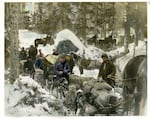
Sled dogs played a critical role in the Klondike Gold Rush in the 1800s.
National Park Service
That’s because humans have come to realize that sled dogs are naturally good at pulling things.
“If you grow up around working animals, you realize it’s in their genes, it’s in their blood,” McCracken said.
And most of them love to do it.
Sled dogs are bred for traits like work ethic and desire. In “The Sports Gene,” Epstein wrote that some mushers think sled dogs are nearing their physiological capacity. Genetic motivation is now what sets dogs apart.
The dogs pull instinctually, but they’re trained to run. Not all of them keep up with the sport. Some dogs retire due to injury, others old age.
Curley said it’s the dogs’ choice. They won’t pull if they don’t want to.
“You can’t push a rope,” he said.
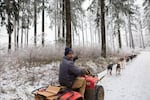
Thad McCracken shouts directions on the trail. These sled dogs receive only verbal commands: "gee" means right, "haw" means left, and "on by" means pass.
Bradley W. Parks / OPB
‘We Race For A Hobby’
Dog sledding has an old-world feel.
People seem to know it mostly as an ancient activity, long ago replaced by snowmobiles, that only lives on during the Iditarod — the famous 1,100-mile sled dog race from Anchorage to Nome in Alaska.
Accounts of the Iditarod can be mystical: tales of sleepless days and nights behind a team of dogs, hallucinating mushers and extreme physical exertion.
Brian Phillips, formerly of the website Grantland, paraphrased a yarn from writer and musher Gary Paulsen's book about the Iditarod, "Winterdance":
“At one point [Paulsen] thinks he's on a beach in California; at another he pulls out a real ax to fend off an attack from an imaginary moose. When he comes to, his dogs have vanished; he's alone in the landscape. He stumbles across them 100 yards away. He has built a fire and bedded them down without knowing it.”
While there’s romance in those awesome tales of long-distance sled dog races, the reality is much more humble for many mushers in Oregon and Washington.
Mushing is a massive investment of time, energy, money and emotion.
"Most of us don't race to make any money," Nuckols said. "We race for a hobby."8
Sled-dog training in the Northwest starts around the time temperatures dip below 50 degrees. The colder the better for the dogs.9
Snow isn’t always abundant here, nor are snowy trails most convenient — especially for weekday running. In the absence of snow, mushers will train their dogs on softer trail surfaces like dirt, mud or gravel, using mostly knobby-tired scooters in place of sleds.
While competitive mushers with big kennels, like McCracken, Nuckols and Curley, are here, most mushers in the Cascade Sled Dog Club have only a few dogs and are just looking for something to do with them.
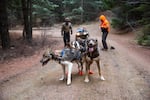
Nuckols, right, and Curley stop to give their dogs water mid-run.
Bradley W. Parks / OPB
Do It For The Dogs
In the past, sled dogs' work was devoted to making life easier for their humans.10
But many mushers in the Northwest run sleds out of devotion to their pets — to make those dogs’ lives as fulfilling as possible.
“That cultural expectation of what a dog is has become so limited,” Lee said.
The Cascade Sled Dog Club seeks to challenge that thinking by making dog sledding more accessible. They hold pull clinics and offer mentorships with experienced mushers. They often spend weekends together, running their dogs before breaking bread. (Lee calls the CSDC “a food club with a dog problem.”)
And a lot of members’ sled dog stories seem to start the same way: “I got my first dog and … ”
Take Kim Tinker, the skijor champ. She was a downhill skier and grew tired of crowds and expensive lift tickets. Tinker got a dog for free at a feed store and farm supply in Boring, Oregon. She took the dog cross-country skiing.
“And the dog was always pulling me. So I thought, ‘Oh my god, I think I invented a sport,’” Tinker said. “Well, come to find out I didn’t invent a sport, but I became addicted to a sport very quickly.”
That sport is called skijor, where a dog or team of dogs (sometimes horses) pulls a person on skis.
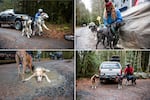
Clockwise from top left: Laura Maffei holds onto her Alaskan malamutes, Tai and Takara; Lou Wolf fastens her dog Jonny's harness; Kim Tinker connects her Alaskan huskies, from left, Ikuma, Summit and Raven to tug lines; Dale Leix's Alaskan husky, Taz, and black mouth cur, Bug, cool off and drink from a puddle.
Bradley W. Parks / OPB
Tinker and her dog won the Pacific Northwest Skijor Championship in just their second year participating in the sport.
“This dog was incredible. Everybody’d go, ‘What kennel’s that dog from?’ I’d go, ‘Geren’s feed store, free to a good home,’” she said, laughing.
There’s Laura Maffei and her husband, Noel Snyder, who run their four Alaskan malamutes in the winter and enter two of them in dog shows in the summer. Or Dale Leix, whose team of two includes an Alaskan husky and a black mouth cur, a hound dog from Georgia. Or Lou Wolf, whose dogs are named for mushing legends. Or Nathan Clements, who runs four Siberian huskies — all rescues.
Ask any of them and they’ll tell you they do it for the dogs first and foremost.
“I really do it more for the dogs because they love it,” Clements said. “Seeing the smile on the dogs’ faces after being out there on a run is totally priceless.”
‘A Non-Human Form Of Person’
The bonds created with their dogs are hard for mushers to put into words.
Historically, it showed in how the dogs were treated at death, according to Losey. Many dogs his team found at Ust-Polui were given proper burials, sometimes alongside humans.
“I’ve spent time studying groups in the past who believe that not only were dogs part of the family, but they were in a sense kind of a non-human form of person,” he said.
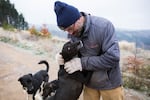
Thad McCracken hugs his dog Wyatt after a 12-mile run.
Bradley W. Parks / OPB
Mushers nowadays describe the bond in moments like the takeoff or the first time they felt their team pull or the gleam in a dog’s eyes after a run.
For Tim Curley, it’s when he and his dogs are alone together, running through Oregon forests in the dark of night.
“The dogs are a little more happy, a little faster,” he said.
With moonlight reflecting off fresh snow, Curley doesn’t need a headlamp.
“You can turn it off and you can see everything. Usually, the mountain’s out and you can see the mountain in a full moon.”
1 McCracken’s retired dogs stay in the family. They still live and play with the racers and puppies; they just aren’t pulling sleds. return
2 “Beef water” is literally ground beef soaking in a bucket of water. Dogs don’t necessarily think to hydrate before a workout like a human runner would. McCracken said the beef (or chicken, fish or whatever’s available) makes the water more appealing to the dogs, so it aids proper hydration. return
3 An example of working dogs requiring “more”: During the Iditarod, sled dogs often eat 10,000 calories a day. return
4 “The Sports Gene” has an entire chapter devoted to sled dogs, but the full book is a must-read for anyone interested in how the world’s best athletes become the world’s best athletes. return
5 Alaskan huskies are bred specifically to run sleds. Genetically, Alaskan huskies constitute their own distinct breed, but the American Kennel Club does not recognize them as such, so there is no breed standard (at least in the U.S.). Alaskan huskies can vary in appearance and size depending on the musher’s desired qualities. They’re the preferred breed for many mushers for their unique combination of endurance, speed and work ethic. Siberian huskies are also popular sled dogs but not quite as much as their Alaskan cousins. return
6 The cacophony of sled dogs barking before a run is almost like one of those optical illusions where you stare at a picture and different picture pops out. I swore I could hear people calling my name amidst the barking. return
7 Though not the most popular choice, ATVs allow mushers to control the dogs’ pace, stop for water or injuries and also prevent damage to sleds when trails have insufficient snow. return
8 First place prize money for even the best-known sled dog race, the Iditarod, was a modest $19,600 in 2016. Compare that to $2.96 million for tennis singles winners of the Championships Wimbledon in 2017 or $1.98 million for the Masters golf tournament winner. Jeff King had won the most total prize money — $921,244.78 — of any 2017 Iditarod competitor; he’s run the race 11 times and won four. return
9 This is somewhat true of marathon runners too. Endurance is partly a product of the body’s ability to regulate temperature. The ideal temperature for a fast marathon is in the mid-40s Fahrenheit, according to researcher Yannis Pitsiladis, featured in “Man vs. Marathon” by Jeré Longman in The New York Times. return
10 In some historical cases, humans ate their sled dogs. "They really gave their entire lives and even gave their bodies at death to their human companions," Dr. Robert Losey said. "Their whole life in a sense was a sacrifice in serving people, which I think is really quite profound." return

